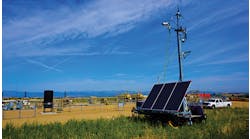"There are use cases out there in the market of people being connected,” said Parkinson. “They're doing this to improve their network security, or they are upgrading their automation from legacy information environments, or they are figuring out if they are needing more in terms of information visibility from Rockwell's MES and information portfolio. But what does a connected enterprise really look like if you put all those pieces together? Some are very connected. Take the automotive industry—they have been integrating information into the manufacturing facility for a long time. However, in some industries, it’s not an integration; it's more of a handoff."
Also read: The Connected Enterprise: An Introduction
Industrial business drivers include smart manufacturing and related government coalitions, industry consortiums and standards, and buzzwords such as the Internet of Things (IoT). "Where's the adoption around the Internet of Things?” asked Parkinson. “There's a lot of hype around it, but where are we in that adoption stage? Everyone likely is a little connected, but others are very connected.”
With the IoT, most machines have information enablement built into the machine, but where and to whom does that information flow? In many cases, what’s happened traditionally is the data has been localized to the users of that equipment and perhaps the people who are maintaining that equipment, explained Khris Kammer, manager, information software, Rockwell Automation.“More and more, what we’re seeing is that, when we’re connecting these sensors, devices, people and machines together, we have an unprecedented opportunity to bring information to people who didn't have it before for the purpose of them improving the process,” he said. “This is the central theme of the enterprise manufacturing intelligence story—bringing the right information to the right people at the right time."
That cannot happen without the information sources. “This information can come from machines, but it can also come from people who are working and interacting with the process,” explained Kammer. “We can do that with low-effort and no-effort user interfaces. It used to be a lot of typing in data. Being connected eliminates the user having to translate what's going on with the process or machine. Instead, we are using the equipment to do that and letting the people consume it in a form that makes sense to them based on their roles."
About one-third of industry is deploying Industrial Internet of Things (IIoT) or will be soon, according to LNS Research. And according to an IndustryWeek Survey, "Approximately 14% of industry is completely connected, but 80% have some connectivity between their operations and enterprise systems. Where are you, and what is your road map?” asked Parkinson, who advised the audience to learn from the experiences of those who have started to make these connections and learn where the value comes from.
"The Connected Enterprise improves efficiency by transforming information into insight, increasing ROI, getting to market faster and dramatically reducing waste," said Parkinson, who offered an example of a cookie manufacturer with a rush order of 50,000 cookies with custom recipe and custom packaging.
"Approximately 14% of industry is completely connected, but 80% have some connectivity. Where are you, and what is your road map?” Beth Parkinson, market development director, The Connected Enterprise, at Rockwell Automation, explained how to get started at Rockwell Automation TechED.
Without connectivity, the manufacturer didn’t have enough time or capacity. It was slow work to reconfigure machines, change quality systems and update package graphics. With the more efficient Connected Enterprise, a real-time view of plant performance and global operations was available. OEE and the schedule were visible, and the new recipe was easy to change due to the integrated, automated processes. Location awareness of the process steps, authenticated security for changes, standard protocols, automatic system adjustments and tracking of all ingredients made for an efficient changeover.
"The Connected Enterprise improves collaboration among people, among teams and among departments, and even among the machines themselves," proclaimed Parkinson. "They had a powerful ability to collaborate." For example, without collaboration, a rush order may be halted due to an unexpected failed bearing. "In the past, nobody would have noticed this problem until it occurred. With smart sensor connectivity, the increased friction and heat were detected."
The connected machine and smart sensors allowed three things to happen. It notified the operator via mobile tablet. The machine could also self-diagnose and schedule maintenance, possibly avoiding the problem altogether. And the connected machine can also allow the OEM to analyze the data and compare it to other machines to determine what is happening with the machine.
Visibility is the ability to see deeper into operations and logistics, with new ways to link processes and facilities to suppliers and customers, explained Parkinson. An example of this can be found in a product recall scenario. How much do you need to recall? Being connected provides visibility of the lots and logistics due to tracking all phases of the process. The ability to notify other plants, suppliers and the customer of the recall is all possible with proper connectivity.
How can companies take the necessary steps to make The Connected Enterprise real?
“Assess your operations, secure and upgrade your network and legacy automation, leverage and analyze your data, and increase collaboration both internally and externally,” answered Parkinson. “Is there a challenge or risk that they have, or are they trying to identify opportunities where they can get more business? It can be done today, and there are companies actually doing it. It's starting with the pieces of your operations, and adding those pieces together to become a Connected Enterprise."




